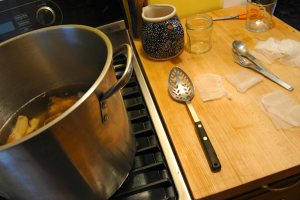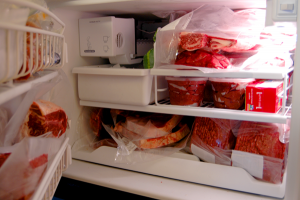
We purchased part of a cow, raised by people we know, and so we are making beef stock. We’ve got a packed freezer and pulling out the bones and a packet labeled ‘soup meat’ made enough room so that we could close the door. Having not really made a batch of stock that we’d be happy to keep around for several months, we decided to consult Harold McGee’s book On Cooking, and Escoffier. It was recommended by both that bones be roasted to impart flavor. And because the main thing bones offer to a stock is substance in the form of gelatin. Roasting will help the bone release what they have. We roasted them in the oven until that just started to turn brown. Then poured off the grease (and saved it just in case we ever needed it.)
In order to get most of the gelatin out of the bones they should be simmered in water for 8 to 24 hours. (McGee)
We covered them with water and added an inch more water to a big stock pot. For the first 1/2 hour it should be check and skimmed when scum comes to the surface. See the photo for the cheesecloth and slotted spoon system we used for skimming. Soon scum becomes insignificant. We let the pot cook on the lowest setting all day. We had a pitcher of water nearby in case the liquid was too hot. It should never boil. We kept it looking like a cute, tiny animal was under the surface constantly releasing a few air bubbles.
Aromatic vegetables like onion, carrot and celery can also be added to the bones. Never add salt.(Escoffier) When anything new is added, there will be scum to skim, but we added both at the same time and skimmed once. We use the tough outside skins of onions that we save for this purpose. Any leftover veggie bits will impart flavor but those from the cabbage family may add some that are too strong. Only add what you’re sure you’ll want in 6 months when you are using this beef stock in a sensitive recipe.The normal veggies Escoffier mentions will mellow the flavor that will come from any meat that is stuck to the bones. We also threw in some unassertive dried herbs and a bay leaf because — it just doesn’t hurt. Salt will concentrate in the finished product, so don’t add any now. By evening when we were tired of thinking about the stock, we strained it and divided it in half.
One half was cooked down while we watched a movie. To the other we added the cubed soup meat, and a few more pieces of aromatic vegetable. This is what Harold McGee calls double stock. After the film, the already strained first half was put in a clean container to cool. The one with the soup meat was strained, and also set to cool. Neither one should be covered until the contents are at room temperature, so go brush your teeth or something and come back. We made the stock in Denver, in December, so we were able to set it on our enclosed back porch uncovered (lid half on) until morning.
Stock making had kept the house warm all day and night, even though it was an odd, very-cold spell. The high temperature that day was only 20 degrees F.
The next morning the efforts of our huge volume of liquid, bones and time had made only a cup of gelatinous glace (first half) and a quart of the double stock. We froze both in ice cube trays and thought of the special occasions when we could use these special morsels. It seem liked a lot of work for such a small amount. But there is a silver lining.
The stuff tastes great.
I added 2 Tablespoons of the double stock to 2 quarts of a white bean soup and it was awesome but not overpowering. That’s right – I used one ice cube of stock. Powerful.
One-quarter cup was added to a 1/2 bottle of red wine that surrounded a pot roast and it was a delicious sauce all on its own. We just took the meat out, cut it and poured the sauce into a server. You could thickened it, add milk or other liquids if you want the look of normal gravy, but this sauce was like getting lucky it was so good.
The small concentrated amount was what we were hoping for – since our freezer is so jammed – but in a normal situation, the process could have been stopped sooner. Less flavor would have adorned the December Denver air if a larger container of stock could have been stored.
Stock will last for a year in the freezer. The same is true of the concentrated bone stock, which is technically a glace.
Somewhere between full- and demi- and truly incredible.
A full freezer
 We picked up an entire cow from the processor in Pierce, Colorado yesterday. We are 1/8th owners of this cow and most of it is right here. A very red freezer.
We picked up an entire cow from the processor in Pierce, Colorado yesterday. We are 1/8th owners of this cow and most of it is right here. A very red freezer.
The cow was raised on John and Jane Francis’ ranch near Cheyenne Wyoming. At Pure Wyoming Beef, they sell 1/4, 1/2 or whole cows, it’s best to go in with friends. Our beef, now no longer on the hoof, is an average price of less than $3/lb. after the processing. So for natural beef it’s a very good deal even for hamburger. The standing rib roast is beyond Smoking Great Deal.
